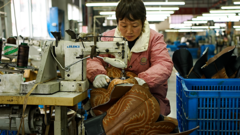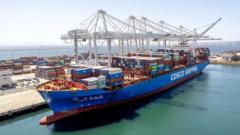As the specter of renewed trade battles looms, Chinese manufacturers navigate uncertainty and loss
Trump's Tariff Threat: China Braces for Economic Turmoil as Manufacturers Relocate

Trump's Tariff Threat: China Braces for Economic Turmoil as Manufacturers Relocate
Concerns escalate as Trump signals potential new tariffs on Chinese goods
In a bustling factory on China's eastern coast, the sound of machinery blends with the history of American cowboy boots being crafted. "We once sold a million pairs of these annually," shares Mr. Peng, the sales manager at this factory, reflecting on better times before tariffs under former President Donald Trump changed everything. As Trump returns to the political spotlight with plans for a potential return to the White House, the Chinese manufacturing sector is wary, fearing a potential resurgence of damaging tariffs on their goods.
Mr. Peng's factory, a symbol of thriving trade, now faces an uncertain future, echoing remarks made by industry experts about the need for adaptation in a shifting geopolitical landscape. Following a series of sharp tariffs during Trump's first presidential term, many companies are eyeing alternatives to China to escape mounting costs. With large brands like Nike and Adidas moving production lines to Southeast Asia, fears grow that smaller factories may soon follow suit.
The stakes are incredibly high; businesses reliant on exports are deeply affected by Trump's economic maneuvers. Following a 15% tariff imposed in 2019 that already decimated order numbers and reduced the workforce from over 500 to just above 200, any hint of a new 10% levy could be the breaking point. Mr. Peng reveals that skilled workers, some who have been with the factory for decades, would likely suffer if production were to relocate, leaving a profound impact on local communities.
Additionally, further complicating matters are persistent tensions between the US and China. Although Trump's approach may signal a mild thaw, his threats still cast a long shadow. The American Chamber of Commerce in China found over half of their surveyed businesses are concerned about the stability of US-China relations. A renewed push for tariffs risks unravelling any progress that might develop from perceived negotiations.
Meanwhile, Chinese businessmen like Huang Zhaodong have pivoted quickly; with operations now in Cambodia, they hope to meet the demands of U.S. corporate giants while sidestepping escalating tariff costs. Personal anecdotes highlight the real consequence felt by producers, revealing that a 10% tariff could decimate profits and limit growth. Such relocation efforts, however, also signify a changing landscape for global supply chains, with many Chinese factories now finding refuge in Southeast Asian nations.
As the impending threat of tariffs echoes through Chinese businesses, experts advise diversifying and exploring opportunities in countries like Africa and Latin America, potentially reshaping global economic dynamics. While manufacturing may migrate, the balance of trade continues to favor China; a recent report states exports have surged, underscoring that the Chinese economy remains a central hub.
For many, the hope remains that diplomatic discussions can temper future tensions. As Mr. Peng optimistically suggests, fostering an environment for open, constructive dialogue could keep tariffs "within a reasonable range," allowing essential American markets to coexist with Chinese manufacturing. As realities shift, the focus remains on survival—amid an uncertain landscape that could reshape the future of production and international trade.
Mr. Peng's factory, a symbol of thriving trade, now faces an uncertain future, echoing remarks made by industry experts about the need for adaptation in a shifting geopolitical landscape. Following a series of sharp tariffs during Trump's first presidential term, many companies are eyeing alternatives to China to escape mounting costs. With large brands like Nike and Adidas moving production lines to Southeast Asia, fears grow that smaller factories may soon follow suit.
The stakes are incredibly high; businesses reliant on exports are deeply affected by Trump's economic maneuvers. Following a 15% tariff imposed in 2019 that already decimated order numbers and reduced the workforce from over 500 to just above 200, any hint of a new 10% levy could be the breaking point. Mr. Peng reveals that skilled workers, some who have been with the factory for decades, would likely suffer if production were to relocate, leaving a profound impact on local communities.
Additionally, further complicating matters are persistent tensions between the US and China. Although Trump's approach may signal a mild thaw, his threats still cast a long shadow. The American Chamber of Commerce in China found over half of their surveyed businesses are concerned about the stability of US-China relations. A renewed push for tariffs risks unravelling any progress that might develop from perceived negotiations.
Meanwhile, Chinese businessmen like Huang Zhaodong have pivoted quickly; with operations now in Cambodia, they hope to meet the demands of U.S. corporate giants while sidestepping escalating tariff costs. Personal anecdotes highlight the real consequence felt by producers, revealing that a 10% tariff could decimate profits and limit growth. Such relocation efforts, however, also signify a changing landscape for global supply chains, with many Chinese factories now finding refuge in Southeast Asian nations.
As the impending threat of tariffs echoes through Chinese businesses, experts advise diversifying and exploring opportunities in countries like Africa and Latin America, potentially reshaping global economic dynamics. While manufacturing may migrate, the balance of trade continues to favor China; a recent report states exports have surged, underscoring that the Chinese economy remains a central hub.
For many, the hope remains that diplomatic discussions can temper future tensions. As Mr. Peng optimistically suggests, fostering an environment for open, constructive dialogue could keep tariffs "within a reasonable range," allowing essential American markets to coexist with Chinese manufacturing. As realities shift, the focus remains on survival—amid an uncertain landscape that could reshape the future of production and international trade.




















